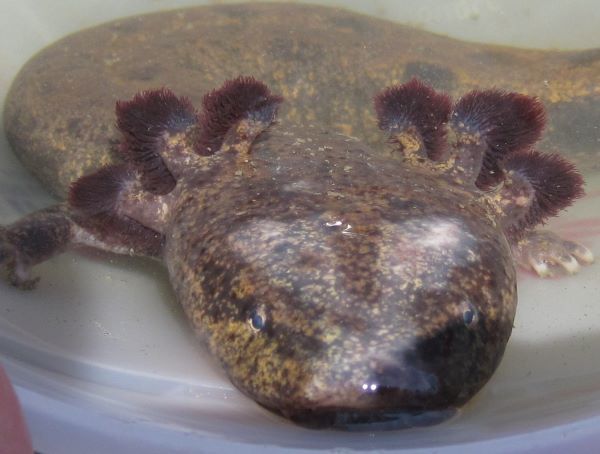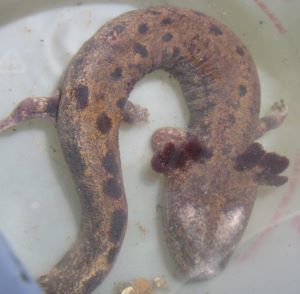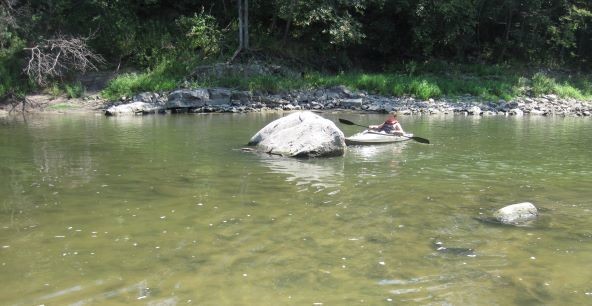 Adult Mudpuppy
“Is it a Mudpuppy?” This is a common question when someone finds a strange tadpole-like creature with legs in a pond or wetland. When they describe a creature with external gills, small legs, a large paddle-like tail and large mouth it usually means they have found a Tiger Salamander larva, especially when the habitat was standing water like a pond or pothole wetland. However, we occasionally get a report when an angler hooks a similar slimy creature with gills and legs from a river, which may be a rare Mudpuppy!
Searching for Mudpuppies

In Iowa, Mudpuppies (Necturus maculosus) are considered rare due to the scarcity of documented records and they are designated a threatened species in the state. Mudpuppy records are scattered throughout several major river basins including the Des Moines, Skunk, Raccoon, Wapsipinicon, Shell Rock, Cedar, Upper Iowa and Mississippi. Mudpuppies are notoriously difficult to catch with standard aquatic techniques like traps, nets, or electrofishing methods, but anglers sometimes catch them while fishing for walleyes or catfish. If you catch one or hear about it, please send photos our way!
|
Mudpuppies are cool!
Mudpuppies are a totally aquatic salamander that retain larval characteristics, like external gills and a paddle-like tail, into maturity. In Iowa, Mudpuppies live their entire lives in streams and rivers, finding shelter under structures like large rocks, logs, or other debris. In neighboring states like Minnesota and Wisconsin, Mudpuppies are found in some natural lakes as well as streams. Mudpuppies forage on a variety of foods like crayfish, aquatic insects, mollusks, tadpoles and small fishes. Most anglers catch Mudpuppies using minnows or other live bait. We hope people release their Mudpuppy catch after taking a few photos and cutting the line.
Making its living in a river can be tough for a Mudpuppy. Large fishes, wading birds, snakes, and semi aquatic mammals want to eat you while constantly changing water levels and poor water quality can make life difficult. Despite these conditions, Mudpuppies survive in some Iowa streams. Mudpuppies breed in the fall, but females don’t lay eggs until spring. Females find a log, rock or hole and attach 60-100 eggs to the underside of the hiding spot. They stick around the nest, guarding it from predators like fishes, crayfish or aquatic insects. After a month or so, larvae hatch and immediately find shelter in rocks, leafy detritus, or other debris. If they survive the many perils of river life, after five years they will mature and the cycle continues.
Mudpuppies are fascinating aquatic amphibians most Iowans don’t get a chance to see. If you catch or hear about a salamander found in an Iowa river, please report it to the Wildlife Diversity Program.

Rocky areas in streams provide good habitat for mudpuppies and their prey.
|
If you've found a Mudpuppy please take a few good photos, release it back into the water and contact the Iowa DNR at 515-298-3071 or paul.frese@dnr.iowa.gov.
|